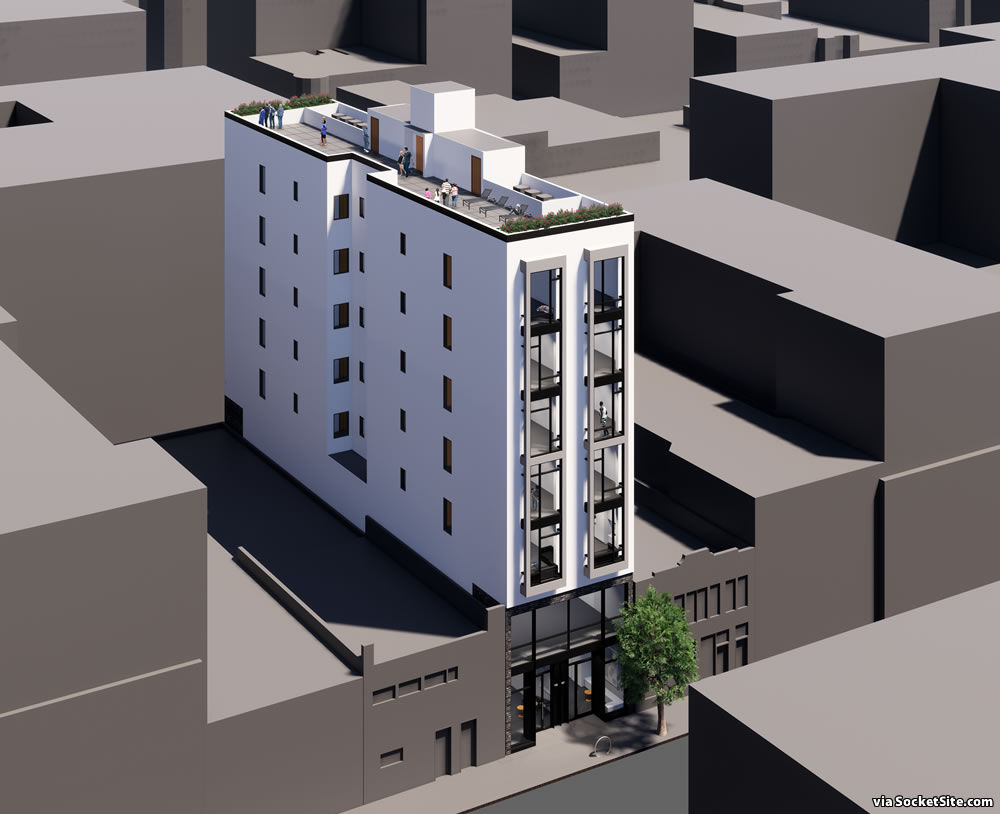As we revealed back in July, the refined plans for a seven-story building to rise up to 85 feet in height upon the Bruce’s Automotive building site at 159 Fell Street, adjacent to the Rickshaw Stop at 155 Fell, had qualified for a streamlined environmental review and both demolition and building permits have been requested.
Subsequently approved by San Francisco’s Planning Commission, the 30-day window within which the community plan exemption for the project, which allowed for the streamlined review, has closed and the project has officially been approved, sans an appeal.
The approved project is slated to yield 24 residential units, a mix of 14 one-bedrooms and 10 twos, over 1,965 square feet of ground floor retail space fronting Fell and Hickory. And once again, the adjacent Rickshaw Stop building, which was purchased for $1.2 million in 2003, is zoned for development up to 85 feet in height as well, as is the parcel on the other side of the garage. We’ll keep you posted and plugged-in.

Any proposed re-development of the Rickshop Stop will run into an army of culture defenders. I wouldn’t be surprised if Rickshaw got an official legacy business / protected status somehow. This new project will keep its western light and views for a long time. Too bad they couldn’t take out the other building next door, though.
As previously outlined, being deemed a “Legacy Business” doesn’t confer any special protections for a business, simply financial support.
Appreciate the correction. Great example of how SS helps me deepen my knowledge of local real estate.
I often criticize the various renderings put up here, but in the credit where credit is due department, I’d like to compliment this one; they followed a rather unusual practice here: stripping detail from most of the surrounding buildings – and treating them monochromatically – but giving just a little more detail to the immediate neighbors….I think it’s a good compromise b/w providing necessary context, and being a distraction. Bravo!
Yeah, not bad. Other builders should take note.
guess you can kiss the rickshaw stop goodbye. once this building is built, they’ll be buried under noise complaints and other forms of officially sanctioned harassment. only consolation is that at the pace things work around here, that won’t happen for another few years at least.
Slims had this problem so the BOS passed legislation that effectively prohibited noise complaints against legally operating entertainment venues. Thankfully Rickshaw Stop should be safe! It’s BOS Ordinance 70-15.
[Editor’s Note: Legislation To Protect Clubs From Encroaching Condos (circa 2015).]
Bruce’s Automotive is an institution, this must be stopped.
I am doubtful this design makes any economic sense and relatively confident it will not be constructed in the next 5 years.
I don’t doubt that’s the case. What I don’t understand is why the development team would request both demolition and building permits if they just intended to entitle and sell it to a greater fool.
Would the marginal increase in selling price they’d get from having the permits in hand really (more than) cover the increase in carrying costs?
Has someone actually paid for demolition and building permits? Typically the planning approval is only the first phase and approval there does not mean the project is ready to break ground.
Buying an existing building with several vacancies would seem like a more obvious move for a rational investor in the current market.
If I’m imagining the floorplan of this building correctly, if the two neighboring parcels build up similarily then all of the lot line windows will be covered and almost half of the apartments are left with a single lightwell window.